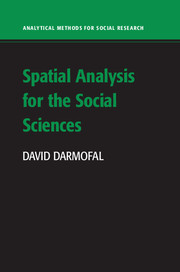Book contents
- Frontmatter
- Contents
- List of Figures
- List of Tables
- Preface
- PART I GENERAL TOPICS
- PART II ADVANCED TOPICS
- PART III APPENDICES ON IMPLEMENTING SPATIAL ANALYSES
- Appendix A Getting Data Ready for a Spatial Analysis
- Appendix B Spatial Software
- Appendix C Web Resources for Spatial Analysis
- Glossary
- Bibliography
- Index
Appendix B - Spatial Software
from PART III - APPENDICES ON IMPLEMENTING SPATIAL ANALYSES
Published online by Cambridge University Press: 05 November 2015
- Frontmatter
- Contents
- List of Figures
- List of Tables
- Preface
- PART I GENERAL TOPICS
- PART II ADVANCED TOPICS
- PART III APPENDICES ON IMPLEMENTING SPATIAL ANALYSES
- Appendix A Getting Data Ready for a Spatial Analysis
- Appendix B Spatial Software
- Appendix C Web Resources for Spatial Analysis
- Glossary
- Bibliography
- Index
Summary
Stata®: This software from Stata Corporation, widely used in the social sciences, does not include much spatial functionality in its standard release. However, there are some user-written functions that allow for the diagnosis and modeling of spatial dependence. Commands written by Maurizio Pisati allow for the importation and generation of spatial weights matrices, the diagnosis of spatial dependence in the absence of covariates, the diagnosis of spatial dependence for ordinary least squares (OLS) regressions, and maximum likelihood estimation of spatial lag and spatial error models (see Pisati 2001).Weights matrices can be imported from external objects or created in Stata using the spatwmat command. The spatgsa command provides three alternative global spatial diagnostics, Moran's I, Geary's c, and Ord and Getis's G statistic. The spatlsa command provides four local spatial diagnostics, the local Moran's I, the local Geary's c, and the Gi and statistics. Five diagnostics for spatial dependence in OLS regressions can be carried out via the spatdiag command: the Moran's I diagnostic, the Lagrange multiplier (LM) diagnostic against error dependence (LMError), the robust LM diagnostic against error dependence (Robust LMError), the LM diagnostic against spatial lag dependence (LMLag), and the robust LM diagnostic against spatial lag dependence (Robust LMLag). Finally, spatial lag and spatial error models can be estimated via maximum likelihood estimation by using the spatreg command.
Recently, David M. Drukker, Hua Peng, Ingmar Prucha, and Rafal Raciborski have created SPPACK, a Stata module for the estimation of cross-sectional spatial autoregressive models (see Drukker et al. 2013; Drukker, Prucha, and Raciborski 2013a; and Drukker, Prucha, and Raciborski 2013b). The module's spmat command provides a variety of options involving spatial weights matrices. Researchers can create contiguity matrices and inverse distance matrices or import matrices based on variables (such as distances) that are already stored in existing Stata datasets. Features of spatial weights matrices can also be summarized using the spmat summarize command.
- Type
- Chapter
- Information
- Spatial Analysis for the Social Sciences , pp. 209 - 214Publisher: Cambridge University PressPrint publication year: 2015

